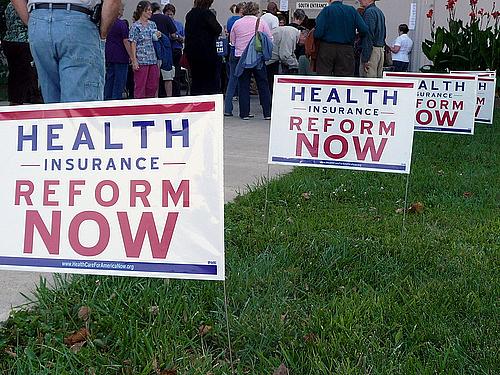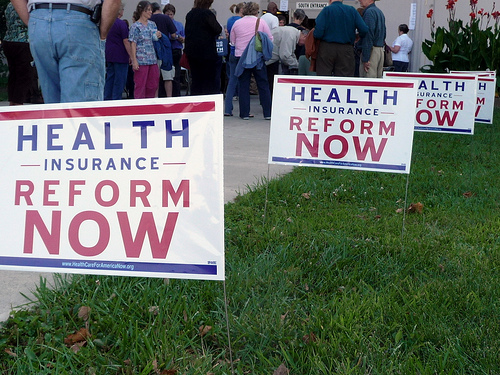Healthcare Reform: The California Challenge

 California has been in the forefront of the move to implement the Obama Administration's new health care reform legislation. But the state is also in the midst of a terrible budget crisis, and is trying to further cut already low Medicaid rates.
California has been in the forefront of the move to implement the Obama Administration's new health care reform legislation. But the state is also in the midst of a terrible budget crisis, and is trying to further cut already low Medicaid rates.
"If this is supposed to be the bellwether state for health reform," asks Noam Levey, a reporter for the Los Angeles Times, "what does it say for everyone else?"
At a seminar with the California Endowment Health Journalism Fellows, Levey and Brietta Clark, a professor of law at the Loyola Law School, discussed the financial and legal challenges surrounding implementation of the new law while Drs. Oscar and Marcia Sablan, who operate a private medical clinic in Firebaugh in California's Central Valley, talked about how to survive financially while continuing to treat a poor patient population in an era of financial austerity.
In order to illuminate the problems, abuses and inequities that prompted the passage of this legislation, Levey outlined the big picture-"what is happening in the American health care system from 30,000 feet," he said.
The three key issues that drove reform are skyrocketing costs; low access compared to other industrialized nations-more than 50 million Americans are uninsured-and poor quality health care, says Levey. "Healthcare costs are breaking the bank for the country and for individuals," he adds, and our health care system "is not nearly as good as people think it is, especially when we compare ourselves to other countries."
The numbers tell the story:
• Since 2000, health care costs have nearly doubled, from below $1.5 trillion to nearly $2.5 trillion this year. If nothing is done to rein in costs, our national health care tab will be close to $5 trillion by the end of this decade.
• Per capita health care costs in the U.S. are $7,538 annually, versus $5,003 in Norway, and $3, 129 in the U.K.
• Average annual premiums for families have tripled in the past dozen years, rising from $5,791 in 1999 to $15,073 this past year.
If nothing changes, Uncle Sam's tab for health care costs will eat up 60% of the federal budget by 2080, according to the Congressional Budget Office.
And we're not getting much bang for our buck.
• We're the only industrialized nation where one in five people lack health insurance.
• We're the only developed country where life expectancy is declining, with women's life expectancy lower in 2007 than in 1987
• Americans struggle to pay their medical bills: more than half of all adults with any chronic condition reported having cost related access problems (54%), versus about a third in Australia (36%) and New Zealand (31%), and less than one out of five in the U.K. (13%) and the Netherlands (7%), according to the Commonwealth Fund.
• Infant mortality rates are higher here than in any other industrialized country: 6.8 deaths per 1,000 live births, as compared to 5.1 in Canada and 2.6 in Japan.
The Affordable Care Act was designed to remedy many of these problems by guaranteeing at least 94 percent of Americans will have adequate, affordable health care; adding consumer protections to put an end to the worst abuses, such as eliminating lifetime and annual coverage limits; and instituting incentivized quality control measures to improve efficiency, eliminate waste and increase quality.
The new bill would provide coverage to 30 million uninsured people by adding about 16-17 million people to the Medicaid rolls and subsidizing coverage for low and middle income people through insurance exchanges, which will be like financial supermarkets. By 2019, the number of uninsured Americans will drop from the current 50 million to around 20 million, according to projections from the Congressional Budget Office.
Among the consumer benefits: no more denials or unaffordable premiums for people with pre-existing medical conditions, or having to worry about getting dumped if they rack up big bills. No co-pays for preventive services, including childhood vaccines, well baby visits, annual physicals and cancer screenings (Pap smears, routine mammography, colonoscopy).
But all of this costs money-which could be bad news for California.
Ironically, the Obama Administration has consistently looked at California as a "pace car" for implementation. "It was the first state out of the block to pass legislation to do the first insurance exchange," says Levey, and moved quickly to address the uninsured problem, even before the massive Medicaid expansion starts in 2014. But in a financially squeezed state of 37 million people, with more than 7 million who are uninsured and 2.5 million undocumented immigrants, extending health insurance coverage under the new legislation may prove prohibitive.
Already, California has the "skimpiest" Medicaid program, says Levey, spending $3,100 per enrollee, compared to Rhode Island, which shells out $8,700 per person. Plans to make even more cuts, by reducing doctors' reimbursements and boosting co-pays for people on Medi-Cal, could run afoul of provisions of the new law, according to Loyola law school professor Brietta Clark, because it could reduce access to health care for this population. Because of the reduction in fees, she says, "Medicaid beneficiaries are having trouble finding providers willing to treat them." Physicians are moving to more affluent areas, she points out, and public hospitals that treat indigent populations are operating in the red and may be forced to shutter.
Still, it is possible to survive, as the Sablans have done for nearly thirty years. They were sent to the Central Valley when they joined the National Health Service Corps as a way to pay off their medical school loans and they ended up staying. Their medical center, which is a federally designated rural health clinic (RHC), is eligible for enhanced reimbursements from Medi-Cal and Medicaid. Patients can get basic medical care at their clinic, but more complicated medical problems that require specialized care can easily escalate into a crisis-and this situation may worsen if medical facilities in underserved areas close.
Even a relatively simple case of gallstones, quite common in Hispanic women after pregnancy, can have "terrible consequences," says Dr. Marcia Sablan. It can take months to get an appointment for treatment at a clinic that takes Medi-Cal, she says. In the meantime, the gall bladder can become gangrenous, leading to death. "If Medi-Cal were more efficient," she says, "the problem would be a lot cheaper to treat and less dangerous."

